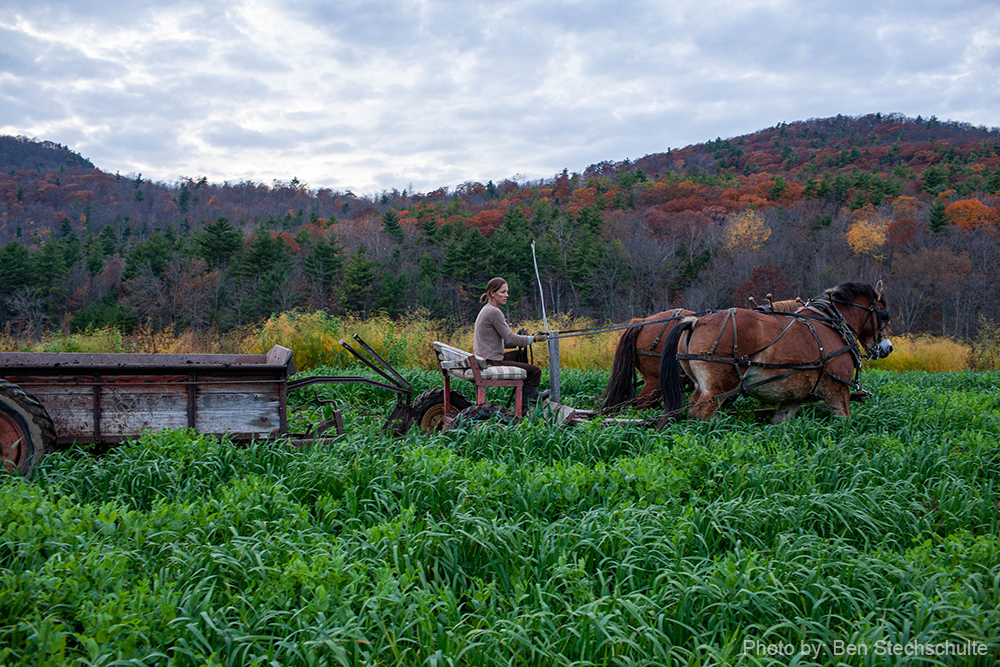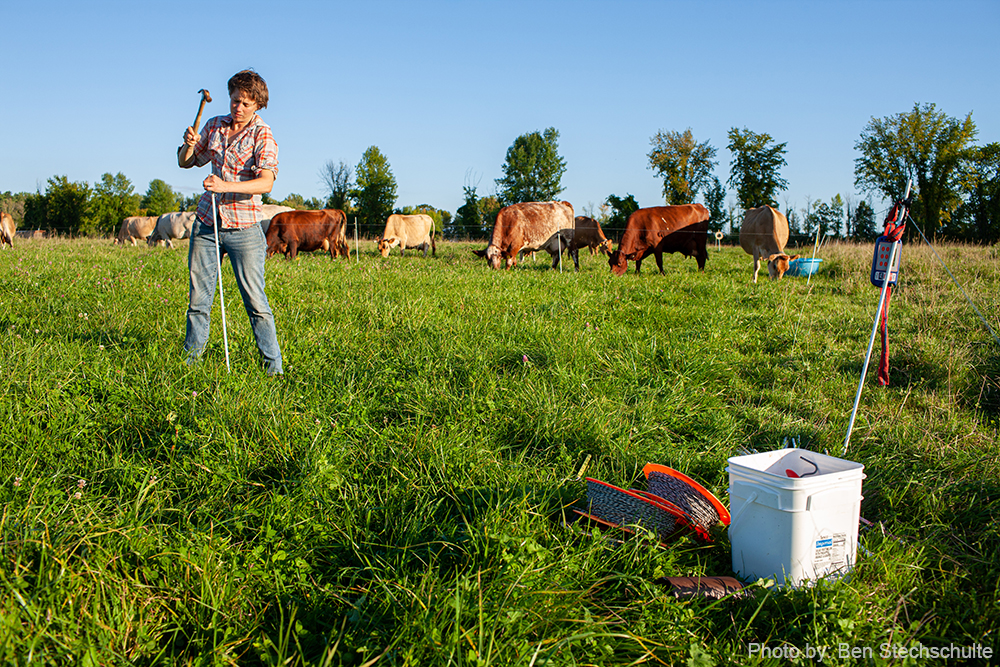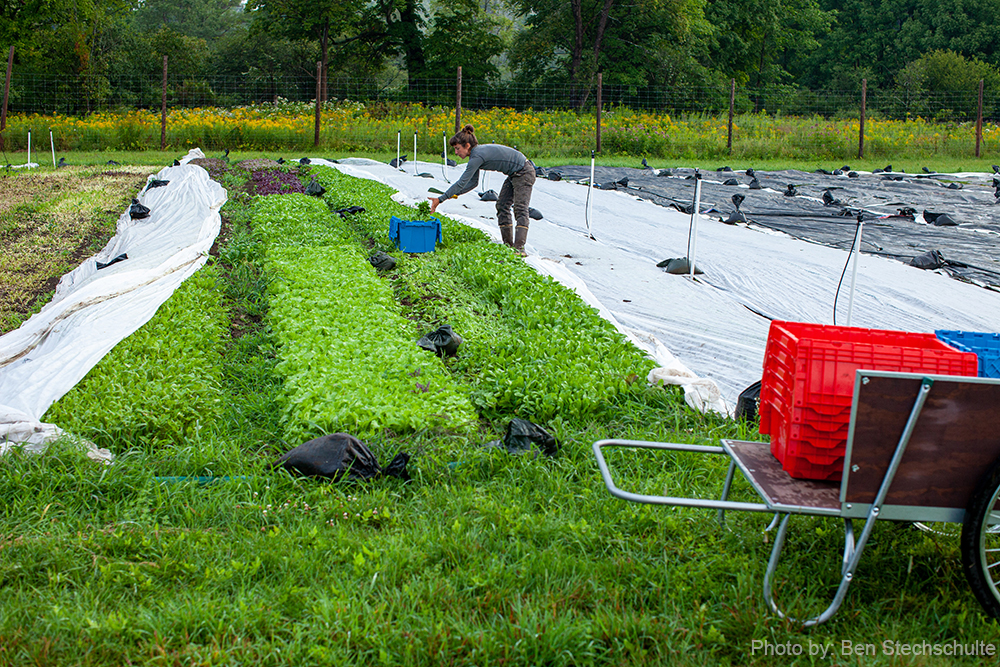
Soil Health’s Role in Fostering Successful Adirondack Farms
By: Charlotte Staats - Adirondack Council Executive and Program Assistant
Friday, November 6, 2020
Farming in the Adirondacks
Farmland is a valuable resource. Most people recognize the importance of agriculture for food, fuel, and fiber, but farmland is also key to environmental stewardship. Agriculture is fundamental in the preservation of working landscapes, open spaces, and vibrant communities. As working landscapes, farmland is ecologically, socially, and economically connected to the Adirondack Park. Agriculture lands protect natural resources, provide healthy food, contribute to the local economy, and bring communities together. There are many environmental benefits to small-scale organic farming practices, including fostering biodiversity, building healthy soils, combating erosion, and sequestering carbon. Most importantly, farms are an essential part of the vision for a healthy and sustainable Adirondack Park.
Agriculture has been a part of the Adirondack Park’s identity since the early 19th century, and continues to be today. The history of farming in the Adirondacks highlights the strong interconnection between people and their surrounding land. Most recently, as the national food supply chain was upended during the COVID-19 pandemic, local communities sought to source more food from local farms. The Park’s ability to provide food to local communities in a time of need brought attention to the importance of having local farms as a viable resource. In addition, as families were burdened with food insecurity challenges, AdkAction and Hub on the Hill with support from Essex Farm Institute began an Emergency Food Packages project that provided over 35,000 meals to local families with healthy food sourced from local farms. In many ways, the pandemic highlighted how invaluable local farms are to the Adirondack Park. As communities look to build back stronger from COVID-19, supporting local farms may also be a way to bolster benefits for the environment and communities throughout the Park.
 Horse power at Full and By Farm
Horse power at Full and By Farm
A cornerstone of sustainable agriculture is healthy soils, which influences a farmland’s ability to yield crops, sequester carbon, and improve water quality. Soil health is defined by the USDA Natural Resource Conservation Service as “the continued capacity of soil to function as a vital living ecosystem that sustains plants, animals, and humans.” Managing land for soil health not only helps improve crop health and yield, but offers a variety of environmental benefits including sequestering carbon, increasing water retention and infiltration, and improving water and air quality, diversity, and habitat. There are many practices that can be employed by farmers to improve soil health. Policy, initiatives, and incentives from New York State can also encourage good farming practices that improve soil health.
Why is Soil Health Important?
Managing farmland for healthy soil enables farmers to work with the land, not against it, to maintain productive, profitable, resilient, and sustainable farms. Healthy soils are complex living ecosystems that reduce erosion, maximize water infiltration, improve nutrient cycling, save money on farm inputs, and improve the resiliency of the land. Ultimately, healthy soil is good for the farm, farmers, and the environment.
Four overarching practices for improving soil health include: minimizing soil disturbance, maximizing soil cover, maximizing biodiversity, and maximizing the presence of living roots. It can further be broken down into specific methods of crop, nutrient, and animal management, agroforestry, and herbaceous cover. Some practices that have been shown to improve soil health are:
- Rotating crops, meaning planting different crops in a field over time.
- Planting cover crops, which are planted to help the soil through nutrient fixing, reducing erosion, and enhancing organic matter levels.
- No-till farming, which leaves soil undisturbed and largely intact.
- Improving nitrogen fertilizer management and utilizing organic soil amendments, which reduces leaching and emissions, while improving soil quality.
- Integrate and rotate livestock through fields.
- Alley cropping, where trees or shrubs are planted in rows within other crops.
- Practicing silvopasture, a method of integrating forestry and foraging livestock.
- Keeping buffer strips, which are areas of permanently vegetated strips of land that can stop undesired movement of sediments and nutrients while providing natural habitat for wildlife.
Utilizing these techniques improves soil physical make-up, depth, nutrient availability, and the ability to store and drain water properly. It also keeps pests and pathogens at low levels, increases the population of beneficial organisms, reduces weed pressure, and makes soil more resilient against overall degradation from weather, human impact, and other potentially harmful factors.
 Rotational grazing at North Country Creamery
Rotational grazing at North Country Creamery
Soil Health Mitigates Climate Change
In addition to being beneficial for farms and the local environment, managing for soil health also has larger environmental impacts. On a broad scale, soil regulates many biological and physical processes between the atmosphere and the lithosphere, including the water cycle, nutrient cycles, and carbon cycle. Healthy soil can absorb, filter, and store water and nutrients better, while also being more resilient to changing weather patterns and climate. Healthy soils also create more biodiversity, which is naturally more resilient against invasive species.
New York State passed the Climate Leadership and Community Protection Act (CLCPA) in 2019, which set ambitious targets for state emissions reductions. Land preservation and stewardship through agriculture and conservation will play an important part in achieving these ambitious goals. Offsetting greenhouse gas emissions through carbon sequestration practices is one method in which the state can reduce overall emissions rates. Healthy soil is really good at capturing and storing carbon. Microorganisms found in healthy soil, and the plants that grow in healthy soil, naturally capture carbon. When soils are left undisturbed, carbon can be stored for thousands of years. Not only that, but practices that improve health naturally have a lower carbon footprint (not running machinery to till fields means less burning of fossil fuels!).
What New York State Can Do to Promote Soil Health
Managing land for soil health is not a new one. In fact, indigenous people’s traditional farming practices, such as crop rotations, have been preserving soil health for thousands of years around the world. Over the last 20 to 30 years, the present-day understanding soil health and implementing good, sustainable practices have evolved. Building up soil to maximize health and productivity can take decades while degrading soil can occur in a matter of a few years. Implementing good soil practices takes time, education, and capital. It can require learning new techniques, purchasing different equipment that farmers might not have, and additional labor costs.
 Black plastic mulch suppresses weeds at Wild Work Farm
Black plastic mulch suppresses weeds at Wild Work Farm
Currently, New York State has several programs to promote soil health practices in agriculture. The New York Soil Health Initiative (NYSH) is a program funded and supported by the Department of Agriculture and Markets, Cornell University College of Agriculture and Life Sciences, and the United States Department of Agriculture Natural Resource Conservation Service. The program’s purpose is to build on current strengths and momentum of stakeholders, coordinate the exchange of information, and identify barriers and opportunities to encourage the adoption and implementation of soil health practices. In 2019, NYSH released a roadmap that outlines research, outreach, and policy priorities to achieve goals identified by various stakeholders. The roadmap identifies barriers and incentives to adopting soil health practices. Four broad goals, which are broken down into policy, research, and outreach goals, identified by the report are:
- Institutionalize a stakeholder network and organizational framework for soil health collaboration, communication, and priority setting.
- Identify and take steps to overcome barriers to wider adoption of soil health practices.
- Integrate climate change adaptation and mitigation research, outreach, and policy with soil health programming.
- Integrate water and nutrient management research, outreach, and policy with soil health programming.
To fund soil health practices, New York funds grants through the Climate Resilient Farming Program. One of the three project categories farmers can be awarded money for is soil health systems. This past year, $1 million was available in grants through the Healthy Soils NY initiative, solely to improve soil health on farms in New York.
Conclusion
Healthy soils are foundational to the long-term success of our Adirondack farms and environment. Farmers can work with the land to improve their yields, reduce their carbon footprint, and sustain viable farmland for the future. New York State continues to recognize the importance of soil health and explore new innovative ways that it can help support healthy soils across the state. As resources to support soil health grow, it will be crucial for agriculture in the Adirondack Park to leverage and implement new practices to support the long-term success of local farmland. Agriculture is a central pillar of the Adirondack Park. When our local farms prosper, so does our local community, economy, and environment. It all starts from the ground up.

Charlotte Staats joined the Adirondack Council as the Executive and Program Assistant in April 2020. She assists the Executive Director and Program staff with communications, program planning and management, and other support to ensure that the Council runs smoothly and achieves program goals. Charlotte grew up in Westport along Lake Champlain, graduated from Clarkson University with a BS in Environmental Science and Policy in 2017, and spent five seasons working for the Adirondack Mountain Club's professional trail crew. Beyond going outside to enjoy the natural world whenever she can, Charlotte also loves to watercolor, dance to live music, cook, and spend time with her family and friends.




